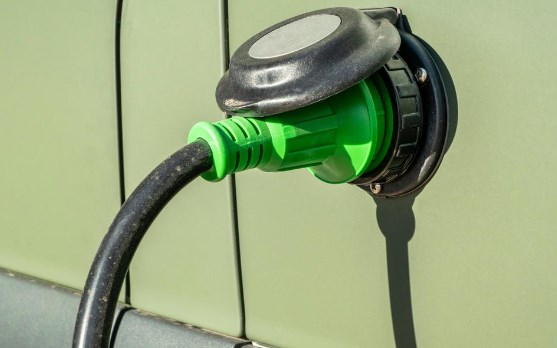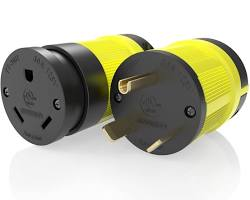OUTLINE:
How to Wire 30 Amp RV Plug - No Shocks Guaranteed!
 261
261Ready to connect your RV to campsite power and unlock a world of creature comforts? Let's break down the steps you need to follow for safe and successful wiring of a 30-amp RV plug.

The Functions Of A 30-Amp RV Plug
Here are the key functions of a 30-amp RV plug:
1. Providing Power:
- Primary purpose: To connect your RV to an external power source, usually at campgrounds or RV parks.
- Power supply: Delivers 120 volts of AC power at a maximum of 30 amps, enough to run most RV appliances and systems.
2. Ensuring Safety:
- Grounding: The plug includes a grounding wire (green or bare) to protect against electrical shocks and electrical fires.
- Circuit protection: Built-in circuit breakers or fuses protect the RV's electrical system from overloads and short circuits.
3. Compatibility:
- Standardized design: Uses the NEMA TT-30R configuration, widely recognized in North America, for compatibility with most campsite power pedestals.
How To Wire A 30-Amp RV Plug
Mastering the art of wiring a 30-amp plug might seem daunting, but with the right tools and a clear roadmap, you'll be cruising into campgrounds with confidence. Buckle up, and let's dive into the details!
Gather Your Gear:
- 30-amp RV plug (NEMA TT-30R): Your key to campsite power.

- Wire strippers: Precision for the perfect peel.
- Crimping tool: Secure those connections like a pro.
- Electrical tape: Insulating safety, one wrap at a time.
- Voltage tester: Double-checking is key to happy amps.
- Safety glasses and gloves: Protection first!
Unveiling The Wires:
- Hot (black): The powerhouse, marked with "L1" or "Hot."
- Neutral (white): Balancing act, labeled "N" or "Neutral."
- Ground (bare or green): Safety net, identified as "G" or "Ground."

Wiring Waltz:
- Strip a generous inch of insulation from each wire end. Twist tightly for secure connections.
- Match the wire colors: Black to black (hot), white to white (neutral), and green or bare to the green screw (ground).
- Crimp wire connectors for a reliable hold. Ensure they're sized for your wire gauge.
- Screw your connections tight: Hot to the brass screw, neutral to the silver screw, and ground to the green screw. Double-check for snugness!
- Seal the deal with electrical tape: Cover exposed wire ends and connections for complete insulation.
Safety Check:
- Double-check your wiring: Colors, connections, and tightness are crucial.
- Test it out: Use a voltage tester to confirm everything's in the green zone.
Common Mistakes To Avoid During The Wiring Process
Conquering the art of wiring a 30-amp RV plug unlocks a world of campsite comfort and adventure. So, before you hit the open road, let's shed light on some common pitfalls to avoid during the wiring process
Color Confusion:
- Mixing up hot and neutral: This misconnection can damage RV appliances and pose a safety hazard. Double-check colors and labels ("L1," "N," etc.) at every step.
- Assuming green isn't always ground: Bare or green wires are both ground, but don't mistake them for neutral (white).
Connection Cripples:
- Loose screws: Ensure all connections are snuggly tightened, or vibrations can lead to arcing and overheating.
- Flimsy crimping: Poorly crimped connectors can cause resistance and potential fire hazards. Invest in a good crimping tool and practice to ensure secure connections.
- Neglecting electrical tape: Bare wire peeking out creates a short-circuit risk. Wrap every exposed end and connection generously with electrical tape.
Testing Traps:
- Skipping the voltage test: This crucial step verifies correct wiring and prevents dangerous situations. Invest in a simple voltage tester and use it before connecting to campsite power.
- Ignoring the manual: Your RV's manual holds specific wiring instructions and recommendations. Don't rely solely on general guides – consult the manufacturer's wisdom for your specific model.
Safety Slumps:
- Ignoring safety gear: Protect yourself with gloves and glasses while working with wires. Electricity doesn't play favorites.
- Rushing the process: Take your time, double-check your work, and don't hesitate to ask for help if needed. Rushing can lead to missed mistakes and potential dangers.
- Underestimating electricity: Respect the power you're handling. Prioritize safety at every step and never take electrical work lightly.
Conclusion
This guide provides safe and responsible instructions for to know how to wire a 30 amp rv plug. By following these steps, you'll be confidently powering up your RV adventures in no time! So, pack your bags, grab your 30-amp plug, and get ready to plug into unforgettable memories on the open road!

Disclaimer: The views and opinions expressed by individual authors or forum participants on this website do not represent the views and opinions of Chipsmall, nor do they represent Chipsmall's official policy.

share this blog to:

